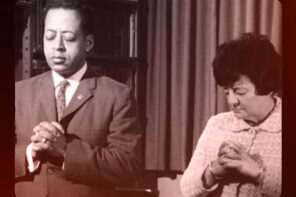In August, a poetry review appeared in the New York Times. Written by Thomas Simmons of the University of Iowa, it declared that Dylan Krieger’s Giving Godhead “will be the best collection of poetry to appear in English in 2017.”
Simmons then went on to describe Krieger’s blend of “the religious with the obscene” as “a new form of the grotesque that marries autobiography to personal and national trauma,” calling the book “easily among the most inventive and successfully performative works to appear in living memory.” Dramatic words for the Gray Lady.

Giving Godhead
Dylan Krieger
Delete Press
August 2017
And a shock, surely, to the small press that had produced the volume. Orders placed in the wake of that review’s publication were filled just this month, an interval that only furthered expectation regarding Simmons’s claim that the poems here went “places I have never seen any poet go before” and that through “the abundant literary, religious and philosophical references embedded in the ingenious wordplay,” the book “blows several giant craters out through the walls of our inherited and now somewhat cowed Western selves.”
On its face, the review is overblown. Yet Simmons’ act of ecstatic praise—especially in this new age of replicating digital commentary—demanded a response, making Krieger’s book instant required reading not only for that righteous remnant concerned with contemporary poetry, but also for those interested in “the religious” as a sort of cultural cloud, a set of ideas and images and assumptions and ingrained reactions—transcendence, blood, moral judgment, shame—in which we live. (We “Western selves,” that is, whether we’re atheists or monks.)
The religious, in this sense, is a framework for consciousness, the vocabulary we are given and out of which we think.
Writing in a frantic, jagged zig-zap rhythm, reminiscent most of hip-hop in the ricochet play of off-rhymes and fast-ripped allusions, Krieger plumbs the visceral heart of Christian tradition—the broken body of the dead man, the virgin writing in labor, plus those scores of angels with swords and prophets who marry whores or eat scrolls and insist the parchment tastes just like the honey of that many-mansioned heaven in the by-and-by sky.
Krieger shows us the bodily as both central to and taboo within that tradition. Something two-faced lurks, these poems suggest, in the way we cry out the word God when we writhe like the damned in hot pits, or how we think of transcending death through the petites morts we tremor through. Our bodies offer both rough bondage and temporary redemption—blood and visions. Krieger insists that the body is “HOLY,” focusing as an explicit interest in what she calls “GODDAMN! AND SEXUALITY.”
Krieger slings a lot of words around—the Word, for instance, the one made flesh to save us from our sinful natures; the safe word, spit out in the midst of fleshly communion, a way to save us from the slip from consensual degradation to the wrong sort of pain, an excess of excess, or the sudden piercing of the wrong kind. One of the words she mobilizes here, lining up like reliquaries to slap down to the floor, is “sacrilege.”
Sacrilege, however, follows a strange dynamic, reinforcing the power of that which gets abused. A thing matters—a name, a statue, a sign—and by inverting it or spitting on it or knocking it off one acknowledges the authority, the sacrality, of that thing. Sacrilege is a form of reverence, though it generally gets more press.
We see this in the contemporary art world, from Pussy Riot to “Piss Christ,” acts and objects that pay homage to that which they are read as defying, defiling. We see it already at the level of language: “sacrilege,” an assault on the sacred. What do you call an assault on that which ones holds in contempt, like the authoritarian structure of a state church or the silent acquiescence to the death of others masked as piety? That’s just talk.
Through art, however, sacrilege can serve also to examine, to open for analysis, the concepts of “sacrality” inherited in our broader culture.
Consider the work of Sophie Calle, for instance. The French conceptual artist—whose most recent work, begun this summer in Green-Wood Cemetery, Brooklyn, involves a grave for the secrets of visitors to that site. That piece, evoking notions of confession and absolution, mortality and temporality, sinks a spade into a whole cluster of theologically fraught ways of thinking and being, raising—as Jack Neudorf pointed out in Art Forum—some important questions for an age in which digital oversharing of confidences generally occurs sans any sense of catharsis.
In an earlier series of photographs of defaced icons, Calle prompts reflexive readings of martyrdom, facelessness rendering such statues more uncanny, even transcendent. A neat trick, not without an eerie beauty: wooden and stone faces battered into mirrors.
Krieger is part of this broader formal tradition: she gives us the rustle of a snake in the grass and urges us to consider our shudder, shows us our nakedness in the garden and times how quickly we snatch for a fig leaf.
Krieger is after the codes that get ingrained, that run in the background, that make us think a certain way about, say, virginity, or sovereignty, those triggers that flip circuits such that suffering immediately flashes in the backs of our mind as redemptive, death as sacrifice, and so on.
Poison, she might say: brainwashing with a dirty sponge.
Despite Simmons’s hagiographic comment regarding originality, the work of Giving Godhead is not without both ancestral figures and fellow-travelers—from De Sade, referenced in these pages, to his later champion Georges Bataille. The overlay of sexuality—and, indeed, eschatology—onto the cosmic echoes both the Manichean systematics of Norman Mailer and the work, likewise cited here, of Allen Ginsberg, himself part of a deep tradition of American “Judeo-Christian” cultural workers who drew from the well of (real and imagined) Eastern monist traditions.
Ramakrishna telling his disciple that two dogs copulating was the face of God: that’s not unrelated to the tone here. But here the face is less friendly, the sovereign of the universe something of which Krieger, again, in that deep American tradition best personified by Herman Melville, remains suspicious of—which is to say armed against.
War in the name of faith is a recurring theme, as with cell-phone videos of beheadings. Krieger reads such rage within a dichotomy of “fundamentalist repression” and its opposite, freedom. Alhough she prefers the phrase “over-pervy libertinism” as, for her, the dichotomy is spread wide, with ISIS on one end and the antinomian carnival of de Sade’s vacation home at the other. That’s a freedom worth fighting for, she implies, but it is far from free. Inherent in Christianity—in the system of thought, not just its history—are empire and violence, Krieger argues, particularly a mode of subjugation and submission to servitude—and its lacerations—that renames abuse as saintliness. Of this she is dubious, though like all good mystics she remains faithful within her doubt.
At once angry about and a devotee of a system that urges you to take it, Krieger has some harsh images to fling back in the faces of the “man-eating bambino[s]… half-breed between pedophile & / child, raptor rapist” who use their collars and incense as tools of predation. She has a bleeding, enflamed heart for those, too, who are erased from the rolls of the lambs who need tending due to their sexual practices. If suffering is to be embraced, that embrace must be capacious, these pages insist.
Some readers won’t make it past the poem titles—some of which, like certain representations of the crucifixion, run hyperbolic in their attempt to fit a theme: “gnostic bukakki” is a bit much, on purpose. Other readers will find there’s simply too many oral sex references per page, though as U2 showed us some dozen albums ago, an oral fixation does come organically with a tradition of wine and wafers, descent and rising up, kneeling and being filled with spirit.
Krieger, like those ridden by rapturous moments at a revival, goes slack sometimes, and this book has its limp, cheap moments, cellophane grass and gassy puns that might only elicit an “organ yawn” from readers.
It may not be the best poetry collection in English published this year—that may, in fact, like rivers of milk and honey or peace and goodwill between all humans on earth, simply not be a thing—but Giving Godhead is a worthwhile example of art using the so-called sacrilegious to call attention to the ubiquitous cultural legacy of Christian theology in our world.
To twist an image Krieger gives us, the bomb wasn’t planted in some legendary garden, but in our minds, by centuries of indoctrination and institutional power structures. Reading these poems will prompt new thinking about old conceptual saws, from shame to salvation, suffering servitude to transcendence from this world of mortal coiling.
As Krieger writes, winking even as she’s pierced in the side: “too bad there is / no christ whistle / or I would blow.”





